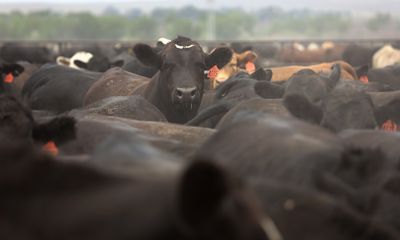April 29, 2016

A University of California, Davis, professor disputes the claim that livestock greenhouse gas emissions are equal to that of transportation sectors.
In a white paper, “Livestock’s Contributions to Climate Change: Facts and Fiction,” Professor Frank Mitloehner says energy production and use, including transportation, are the largest contributors of greenhouse gases that are believed to drive climate change. He says “Meatless Mondays,” a campaign to limit meat consumption, would reduce U.S. greenhouse gas emissions by .6% if practiced by all Americans.
Related: Meatless or Meaty Monday?

UC-Davis professor says U.S. has the lowest carbon footprint per unit of livestock output produced. (Photo: John Moore/Getty Images)
“One certainly cannot neglect emissions from the livestock sector, but to compare them to the main emission sources would put us on a wrong path to solutions, namely to significantly reduce our anthropogenic carbon footprint to reduce climate change,” Mitloehner wrote in his blog.
Leading U.S. scientists and the EPA say the U.S. livestock sector contributes 4.2% of greenhouse gas emissions, compared to 27% from the transportation sector and 31% from the energy sector.
Contributions by species:
-Beef cattle, 2.2%;
-Dairy cattle, 1.37%;
-Swine, .47%;
-Poultry, .08%;
-Sheep, .03%;
-Goats, .01%;
-Other species, .04%.
“In spite of the relatively low contributions to total GHG emissions, the U.S. livestock sector has shown considerable progress during the last six-plus decades and commitment into the future, to continually reduce its environmental footprint while providing food security at home and abroad,” Mitloehnber wrote. “These environmental advances have been the result of continued research and advances in animal genetics, precision nutrition, as well as animal care and health.”
He said the U.S. has the lowest carbon footprint per unit of livestock product produced. For example, the average dairy cow in India produces 2,500 pounds of milk per cow per year and the average Mexican cow produces 10,500 pounds of milk per year. In the U.S., the average dairy cow produces 22,248 pounds of milk a year.
“Improvements in livestock production efficiencies are directly related to reductions of the environmental impact,” he writes.
Mitloehnber writes that intensification of livestock production can feed a growing human population.
“The U.S. livestock, poultry and feed industries are one of the most efficient and lowest environmental impact systems in the world,” he writes. “The research, technologies and best practices that have been developed and implemented over time in the U.S. can also be shared with other production regions around the world.”
You May Also Like




